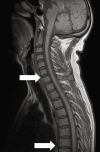Coincidental Coexistence of Human T-lymphotropic Virus Type 1 (HTLV-1)-Associated Myelopathy/Tropical Spastic Paraparesis and Myasthenia Gravis in a Patient With Chronic HTLV-1 Infection: A Case Report
- PMID: 40821191
- PMCID: PMC12357591
- DOI: 10.7759/cureus.88163
Coincidental Coexistence of Human T-lymphotropic Virus Type 1 (HTLV-1)-Associated Myelopathy/Tropical Spastic Paraparesis and Myasthenia Gravis in a Patient With Chronic HTLV-1 Infection: A Case Report
Abstract
Human T-lymphotropic virus type 1 (HTLV-1) infection profoundly alters central immune regulation via molecular mechanisms involving the viral proteins transactivator X and HTLV-1 basic leucine zipper factor, which promote the proliferation of autoreactive T lymphocytes and the dysfunction of regulatory T cells, resulting in persistent inflammation of the central nervous system. These alterations not only explain the occurrence of HTLV-1-associated myelopathy/tropical spastic paraparesis (HAM/TSP) but have also been associated with the development of autoimmune diseases such as myasthenia gravis (MG). While the connection between chronic HTLV-1 infection and MG is still anecdotal, a small number of case studies and limited molecular research suggest a potential link. Recent investigations have identified HTLV-1 tax and pol gene sequences in thymic tissue from MG patients, supporting the idea that the virus can persistently infect the thymus and interfere with the negative selection of T lymphocytes. Here, we present the case of a patient with HAM/TSP for over 12 years who subsequently experienced a myasthenic crisis, confirmed by the detection of anti-acetylcholine receptor autoantibodies. The patient responded favorably to treatment with acetylcholinesterase inhibitors. The absence of thymoma, together with a history of chronic retroviral infection, reinforced the potential role of HTLV-1 as a trigger for autoimmunity in the absence of structural abnormalities. This case illustrates the clinical and molecular convergence between retroviral infection and immune dysfunction, providing further support for a model of virally induced autoimmunity.
Keywords: antibody-mediated disease; htlv-1; human t-lymphotropic virus; myasthenia gravis; neuroinflammation; neurologic complications; neuromuscular autoimmune disease; rare case report; retroviral infection; tropical spastic paraparesis.
Copyright © 2025, Garma-Solis et al.
Conflict of interest statement
Human subjects: Informed consent for treatment and open access publication was obtained or waived by all participants in this study. Conflicts of interest: In compliance with the ICMJE uniform disclosure form, all authors declare the following: Payment/services info: All authors have declared that no financial support was received from any organization for the submitted work. Financial relationships: All authors have declared that they have no financial relationships at present or within the previous three years with any organizations that might have an interest in the submitted work. Other relationships: All authors have declared that there are no other relationships or activities that could appear to have influenced the submitted work.
Figures

Similar articles
-
Prescription of Controlled Substances: Benefits and Risks.2025 Jul 6. In: StatPearls [Internet]. Treasure Island (FL): StatPearls Publishing; 2025 Jan–. 2025 Jul 6. In: StatPearls [Internet]. Treasure Island (FL): StatPearls Publishing; 2025 Jan–. PMID: 30726003 Free Books & Documents.
-
High TCR Degeneracy Enhances Antiviral Efficacy of HTLV-1-Specific CTLs by Targeting Variant Viruses in HAM Patients.Int J Mol Sci. 2025 Jul 10;26(14):6602. doi: 10.3390/ijms26146602. Int J Mol Sci. 2025. PMID: 40724852 Free PMC article.
-
HTLV-1 associated myelopathy/tropical spastic paraparesis (HAM/TSP): Case based discussion of risk factors, clinical, and therapeutic considerations.J Neurol Sci. 2024 Apr 15;459:122973. doi: 10.1016/j.jns.2024.122973. Epub 2024 Mar 19. J Neurol Sci. 2024. PMID: 38520941 Review.
-
Association Between HLA-DRB1*01 and HLA-Cw*08 and Outcome Following HTLV-I Infection.Iran J Immunol. 2007 Jun;4(2):94-100. doi: 10.22034/iji.2007.17185. Iran J Immunol. 2007. PMID: 17652849
-
Human T-Lymphotropic Virus (HTLV): Epidemiology, Genetic, Pathogenesis, and Future Challenges.Viruses. 2025 May 1;17(5):664. doi: 10.3390/v17050664. Viruses. 2025. PMID: 40431676 Free PMC article. Review.
References
-
- Detection of HTLV-I tax-rex and pol gene sequences of thymus gland in a large group of patients with myasthenia gravis. Manca N, Perandin F, De Simone N, Giannini F, Bonifati D, Angelini C. J Acquir Immune Defic Syndr. 2002;29:300–306. - PubMed
-
- Myasthenia gravis. Gilhus NE. N Engl J Med. 2016;375:2570–2581. - PubMed
Publication types
LinkOut - more resources
Full Text Sources
Miscellaneous
